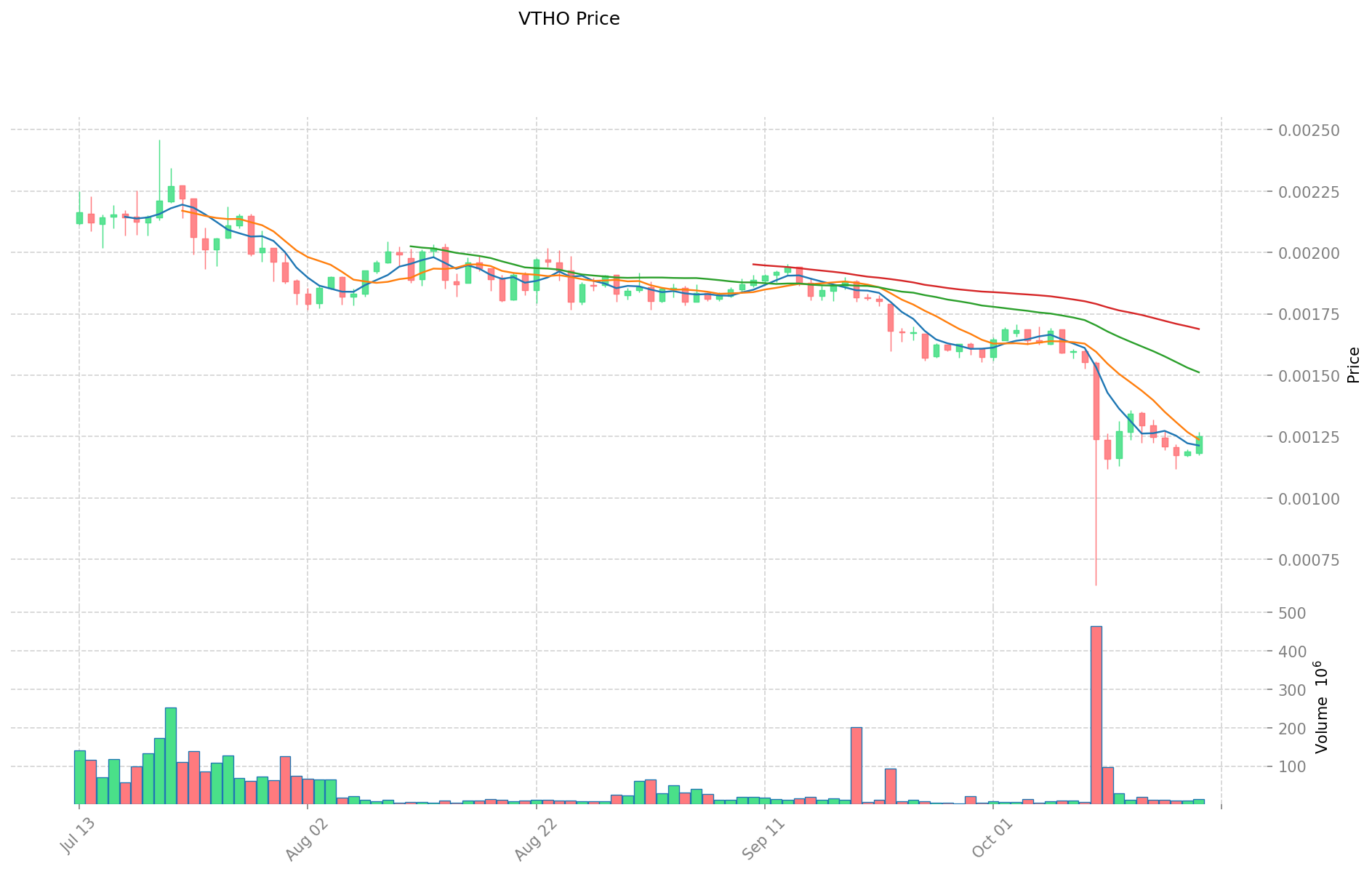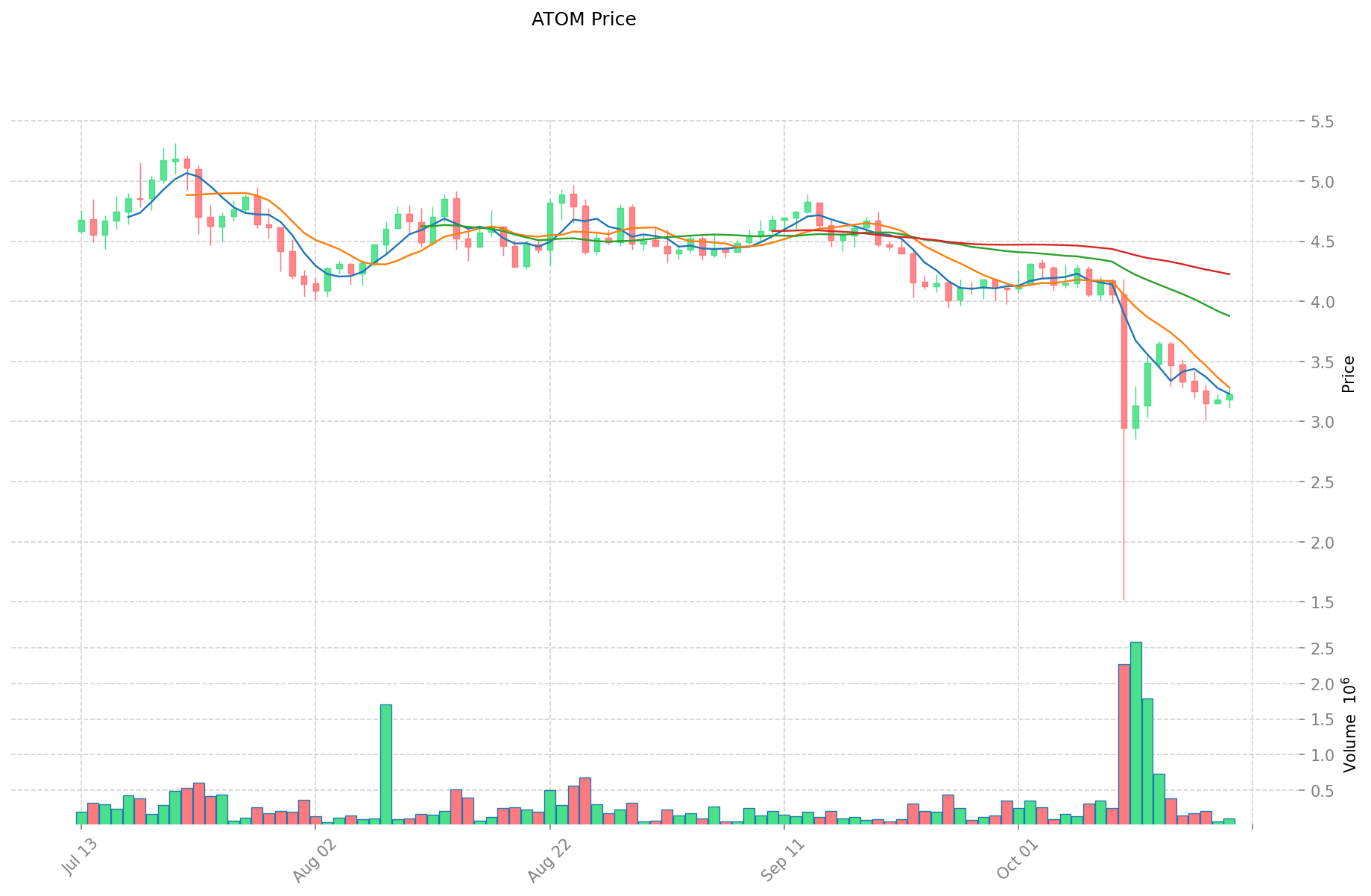VTHO ve ATOM: İki Blockchain Ekosisteminin Karşılaştırmalı Analizi ve Uzun Vadeli Büyüme Potansiyelleri


Giriş: VTHO ve ATOM Yatırımlarının Karşılaştırılması
Kripto para piyasasında VTHO ile ATOM'un karşılaştırması, yatırımcıların daima göz ardı edemediği bir analiz alanı olmuştur. Bu iki varlık; piyasa değeri sıralaması, kullanım senaryoları ve fiyat performansındaki belirgin ayrılıklar yanında, kripto varlıkların konumlandırılması açısından da farklı yaklaşımları temsil etmektedir.
VeThor (VTHO): 2018'de piyasaya sürülmesinden bu yana VeChain ekosisteminde gaz tokenı rolüyle piyasa tarafından kabul görmüştür.
Cosmos (ATOM): 2019'daki çıkışından beri "Blok Zincirlerin İnterneti" unvanını taşımakta ve küresel işlem hacmi ile piyasa değeri açısından önde gelen kripto paralardan biridir.
Bu yazıda, VTHO ile ATOM'un yatırım değerinin karşılaştırılması; geçmiş fiyat trendleri, arz yapıları, kurumsal benimsenme, teknolojik ekosistemler ve gelecek tahminleri üzerinden kapsamlı biçimde analiz edilecek, yatırımcıların en çok yanıt aradığı soruya odaklanılacaktır:
"Şu anda hangisi daha avantajlı alım fırsatı sunuyor?"
I. Fiyat Geçmişi Karşılaştırması ve Mevcut Piyasa Durumu
VTHO ve ATOM Geçmiş Fiyat Eğilimleri
- 2022: VTHO, kripto piyasasındaki genel düşüş sebebiyle ciddi bir fiyat kaybı yaşadı.
- 2022: ATOM, piyasadaki sert düşüşten etkilense de birçok kripto paraya göre daha dirençli kaldı.
- Karşılaştırmalı Analiz: 2022 ayı piyasasında VTHO, zirve noktası $0,04671227'den $0,00015238 tabanına gerilerken; ATOM, $44,45'ten $1,16'ya düştü fakat piyasa değerini daha yüksek seviyede korudu.
Güncel Piyasa Durumu (20 Ekim 2025)
- VTHO güncel fiyatı: $0,00125
- ATOM güncel fiyatı: $3,229
- 24 saatlik işlem hacmi: VTHO $17.771,57; ATOM $305.833,96
- Piyasa Duyarlılık Endeksi (Korku & Açgözlülük): 29 (Korku)
Anlık fiyatları görüntülemek için tıklayın:
- VTHO güncel fiyatı için Piyasa Fiyatı
- ATOM güncel fiyatı için Piyasa Fiyatı


II. VTHO ve ATOM'un Yatırım Değerini Belirleyen Temel Unsurlar
Arz Mekanizması Karşılaştırması (Tokenomik)
-
VTHO: VeChain Thor blokzincirinde kullanım ücreti olarak üretilir, VET sahipliğine göre her gün VET başına 0,000432 VTHO oranında düzenli olarak basılır.
-
ATOM: Yıllık enflasyonu %7 ila %20 arasında değişen, staking katılım oranıyla düzenlenen enflasyonist bir modele sahiptir.
-
📌 Tarihsel Model: VTHO’nun arzı ağ kullanımına göre artarken, ATOM’un enflasyon mekanizması staking’i teşvik ederek ağ güvenliğini güçlendirir.
Kurumsal Benimsenme ve Piyasa Uygulamaları
- Kurumsal Portföyler: ATOM, Cosmos ekosistemi yatırımları ve doğrulayıcı katılımı sayesinde kurumsal ilgide öne çıkmıştır.
- Kurumsal Kullanım: VTHO, VeChainThor üzerinde tedarik zinciri takibi için; ATOM ise Cosmos ekosisteminde zincirler arası iletişimin temelini oluşturur.
- Ulusal Politikalar: Her iki token farklı ülkelerde çeşitli düzenleyici yaklaşımlarla karşılaşırken, ATOM’un yönetişim işlevi VTHO’nun fayda tokenı statüsüne göre daha fazla düzenleyici açıklık sunar.
Teknolojik Gelişim ve Ekosistem İnşası
- VTHO Teknik Güncellemeleri: Ücret delege protokolü, kullanıcıların işlemleri için sponsorların ücret ödemesini sağlayarak kurumsal benimsemeyi artırır.
- ATOM Teknik Gelişim: IBC protokolü, Cosmos ekosisteminde zincirler arası birlikte çalışabilirliği mümkün kılar.
- Ekosistem Karşılaştırması: ATOM, Osmosis gibi uygulamalarla gelişmiş bir DeFi ekosistemine sahipken; VTHO daha çok tedarik zinciri ve kurumsal uygulamalara odaklanır.
Makroekonomik Faktörler ve Piyasa Döngüleri
- Enflasyonist Ortamlarda Performans: ATOM’un staking ödülleri enflasyona karşı koruma sağlarken; VTHO’nun değeri VeChain ağındaki aktiviteye bağlıdır.
- Makroekonomik Para Politikası: Faiz oranları her iki tokenı da etkiler; ATOM’un staking getirisi geleneksel faizli varlıklarla rekabet edebilir.
- Jeopolitik Faktörler: VeChain’in Çin’deki güçlü varlığı VTHO’yu bölgesel düzenleyici risklere açarken, ATOM’un merkeziyetsiz doğrulayıcı ağı daha fazla jeopolitik çeşitlilik sunar.
III. 2025-2030 Fiyat Tahmini: VTHO ve ATOM
Kısa Vadeli Tahmin (2025)
- VTHO: Muhafazakâr $0,00096876 - $0,001242 | İyimser $0,001242 - $0,00176364
- ATOM: Muhafazakâr $2,02734 - $3,218 | İyimser $3,218 - $4,15122
Orta Vadeli Tahmin (2027)
- VTHO, büyüme fazına geçebilir; beklenen fiyatlar $0,00091521738 - $0,00165685905 aralığında
- ATOM, boğa piyasasına girebilir; beklenen fiyatlar $3,7548018205 - $5,484541985 aralığında
- Temel etkenler: Kurumsal sermaye girişi, ETF, ekosistem gelişimi
Uzun Vadeli Tahmin (2030)
- VTHO: Temel senaryo $0,001339797768309 - $0,002232996280515 | İyimser senaryo $0,002232996280515 - $0,002791245350643
- ATOM: Temel senaryo $6,199001034638445 - $7,044319357543687 | İyimser senaryo $7,044319357543687 - $7,748751293298056
Feragat: Bu analiz; geçmiş veriler ve piyasa tahminlerine dayanır. Kripto piyasaları oldukça dalgalı ve belirsizdir. Buradaki bilgiler yatırım tavsiyesi değildir. Yatırım öncesi mutlaka kendi araştırmanızı yapınız.
VTHO:
| Yıl | Tahmini En Yüksek Fiyat | Tahmini Ortalama Fiyat | Tahmini En Düşük Fiyat | Değişim Oranı |
|---|---|---|---|---|
| 2025 | 0,00176364 | 0,001242 | 0,00096876 | 0 |
| 2026 | 0,001653102 | 0,00150282 | 0,0007814664 | 20 |
| 2027 | 0,00165685905 | 0,001577961 | 0,00091521738 | 26 |
| 2028 | 0,0021673294335 | 0,001617410025 | 0,00129392802 | 29 |
| 2029 | 0,00257362283178 | 0,00189236972925 | 0,00113542183755 | 51 |
| 2030 | 0,002791245350643 | 0,002232996280515 | 0,001339797768309 | 78 |
ATOM:
| Yıl | Tahmini En Yüksek Fiyat | Tahmini Ortalama Fiyat | Tahmini En Düşük Fiyat | Değişim Oranı |
|---|---|---|---|---|
| 2025 | 4,15122 | 3,218 | 2,02734 | 0 |
| 2026 | 4,7531469 | 3,68461 | 2,1370738 | 14 |
| 2027 | 5,484541985 | 4,21887845 | 3,7548018205 | 31 |
| 2028 | 6,937945611025 | 4,8517102175 | 3,39619715225 | 50 |
| 2029 | 8,193810800824875 | 5,8948279142625 | 4,185327819126375 | 83 |
| 2030 | 7,748751293298056 | 7,044319357543687 | 6,199001034638445 | 118 |
IV. Yatırım Stratejisi Karşılaştırması: VTHO ve ATOM
Uzun Vadeli ve Kısa Vadeli Yatırım Stratejisi
- VTHO: Kurumsal benimseme ve tedarik zinciri alanına odaklanan yatırımcılar için uygundur.
- ATOM: Ekosistem gelişimi ve zincirler arası birlikte çalışabilirlik fırsatlarını arayan yatırımcılar için uygundur.
Risk Yönetimi ve Portföy Dağılımı
- Temkinli yatırımcılar: VTHO %30, ATOM %70
- Aggresif yatırımcılar: VTHO %40, ATOM %60
- Riskten korunma araçları: Stablecoin tahsisi, opsiyonlar, çapraz token portföyleri
V. Potansiyel Risk Karşılaştırması
Piyasa Riski
- VTHO: VeChain ekosisteminin benimsenmesi ve kurumsal kullanımına yüksek derecede bağımlı
- ATOM: Diğer birlikte çalışabilirlik çözümleri ve Layer-1 protokollerden gelen rekabete açık
Teknik Risk
- VTHO: Ölçeklenebilirlik, ağ istikrarı
- ATOM: Doğrulayıcı yoğunlaşması, IBC protokolünde potansiyel güvenlik açıkları
Düzenleyici Risk
- Küresel düzenleyici politikalar, her iki tokenı farklı şekilde etkileyebilir; ATOM’un yönetişim işlevi, daha az otorite denetimiyle karşılaşabilir.
VI. Sonuç: Hangisi Daha Avantajlı Alım?
📌 Yatırım Değeri Özeti:
- VTHO’nun avantajları: Güçlü kurumsal benimseme, gerçek dünyadaki tedarik zinciri uygulamalarına doğrudan bağlılık
- ATOM’un avantajları: Geniş ekosistem, birlikte çalışabilirlik odağı, staking teşvikleri
✅ Yatırım Tavsiyesi:
- Yeni yatırımcılar: Ekosistem genişliği ve büyüme potansiyelinden dolayı ATOM’a daha fazla ağırlık verebilir.
- Deneyimli yatırımcılar: Dengeli portföy, ATOM’a az farkla daha fazla ağırlık verirken VTHO’nun kurumsal gelişimini izleme
- Kurumsal yatırımcılar: Kurumsal staking ve ekosistem geliştirme fırsatları için ATOM’a odaklanma
⚠️ Risk Uyarısı: Kripto piyasalarında fiyat oynaklığı yüksektir. Bu yazı yatırım tavsiyesi değildir. None
VII. Sıkça Sorulan Sorular
S1: VTHO ve ATOM’un başlıca farkları nelerdir? C: VTHO, VeChain ekosisteminin yardımcı tokenı olup esas olarak işlem ücretleri ve tedarik zinciri uygulamalarında kullanılır. ATOM ise Cosmos ağının yerel tokenıdır, zincirler arasında birlikte çalışabilirlik ve gelişmiş DeFi ekosistemi sunar.
S2: Hangi token tarihsel olarak daha iyi fiyat performansı gösterdi? C: ATOM, VTHO’ya kıyasla genelde daha güçlü fiyat performansı ve dayanıklılık sergilemiştir. 2022 ayı piyasasında, her iki token fiyatı düşse de ATOM daha yüksek piyasa değerini korumuştur.
S3: VTHO ve ATOM’un arz mekanizmaları nasıl ayrışıyor? C: VTHO, VET varlığına göre günde 0,000432 VTHO oranında üretilir. ATOM ise yıllık %7-20 arası değişen ve staking’e göre ayarlanan enflasyonist bir modele sahiptir.
S4: Hangi token daha fazla kurumsal benimseme elde etti? C: ATOM, Cosmos ekosistemi yatırımları ve doğrulayıcı katılımı ile kurumsal ilgi bakımından önde; VTHO ise kurumsal tedarik zinciri yönetimi odaklıdır.
S5: Her token için öne çıkan teknik yenilikler nelerdir? C: VTHO, kurumsal kullanımı artıran ücret delege protokolünü uygulamıştır. ATOM ise IBC protokolüyle Cosmos ekosisteminde zincirler arası birlikte çalışabilirlik sağlar.
S6: VTHO ve ATOM için uzun vadeli fiyat beklentileri nasıl karşılaştırılıyor? C: 2030 yılı için VTHO’nun $0,001339797768309 - $0,002791245350643, ATOM’un ise $6,199001034638445 - $7,748751293298056 aralığına ulaşması bekleniyor.
S7: Farklı yatırımcı profilleri için hangi token daha avantajlı? C: Yeni yatırımcılar, ekosistem genişliği ve büyüme potansiyeli nedeniyle ATOM ağırlıklı tercih edebilir. Deneyimli yatırımcılar dengeli yaklaşım benimseyip ATOM’a hafifçe öncelik verebilir. Kurumsal yatırımcılar, staking ve ekosistem fırsatları için ATOM’a odaklanabilir.
S8: VTHO ve ATOM yatırımlarında başlıca riskler nelerdir? C: VTHO, VeChain ekosistemi ve kurumsal kullanım risklerine açık. ATOM ise diğer birlikte çalışabilirlik çözümleri ve Layer-1 protokollerle rekabet riski taşır. Her iki token da piyasa oynaklığı, teknik riskler ve regülasyondaki değişimlerden etkilenir.

AERO ve ATOM: Mobil Cihazlara Yönelik İki Öncü İşlemci Mimarisi Karşılaştırması

Kripto para fon akışının borsa varlıkları ve zincir üzeri metrikler üzerindeki etkisi nasıl gerçekleşir?

YB vs ATOM: Finansın Geleceğini Belirleyen Dijital Varlık Platformlarının Rekabeti

NAVX vs ATOM: Otonom Araçlar İçin İki Lider Navigasyon Sisteminin Karşılaştırılması

SLN ve ATOM: Moleküler modellemede yaygın olarak kullanılan iki XML tabanlı kimyasal dosya formatının karşılaştırılması

Lombard (BARD) iyi bir yatırım mı?: Tokenomik, pazar konumu ve gelecek potansiyeline dair kapsamlı bir analiz

0G (0G) yatırım için uygun mu?: 2024 yılı Riskleri, Olası Getirileri ve Piyasa Beklentileri Üzerine Detaylı Bir Değerlendirme

WEMIX (WEMIX) yatırım yapmak için uygun mu?: 2024 yılına yönelik Fiyat Performansı, Piyasa Potansiyeli ve Risk Faktörlerinin Ayrıntılı Analizi

FTX Token (FTT) iyi bir yatırım mı?: Borsa çöküşü sonrası FTT'nin riskleri, toparlanma ihtimali ve gelecekteki geçerliliğinin analizi

EGLD ile NEAR: İki Lider Layer-1 Blockchain Platformunun Ayrıntılı Karşılaştırması







